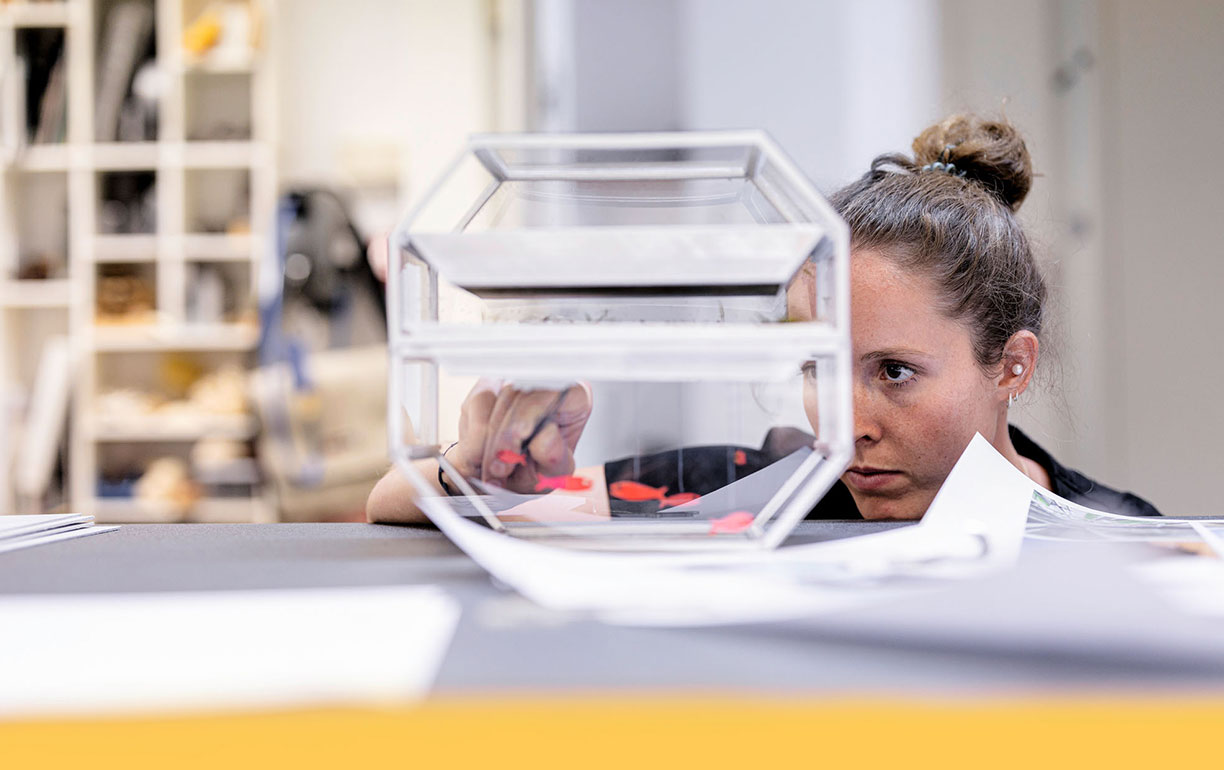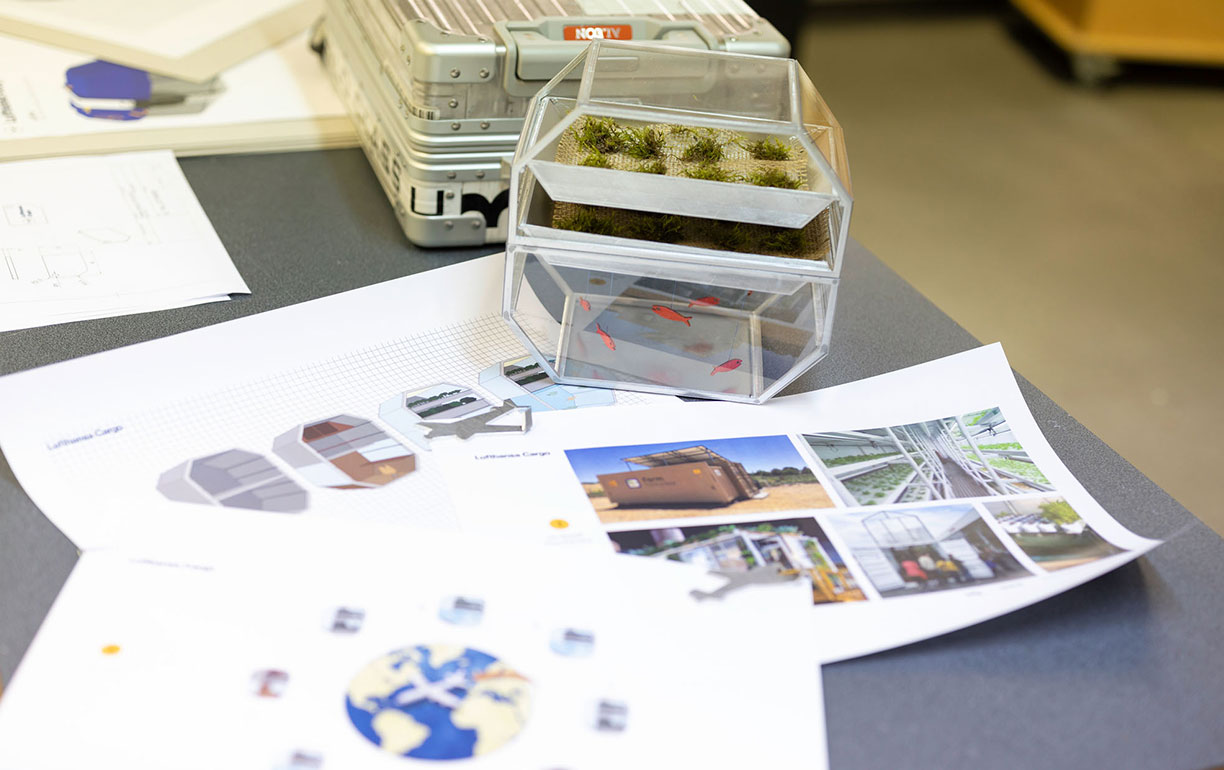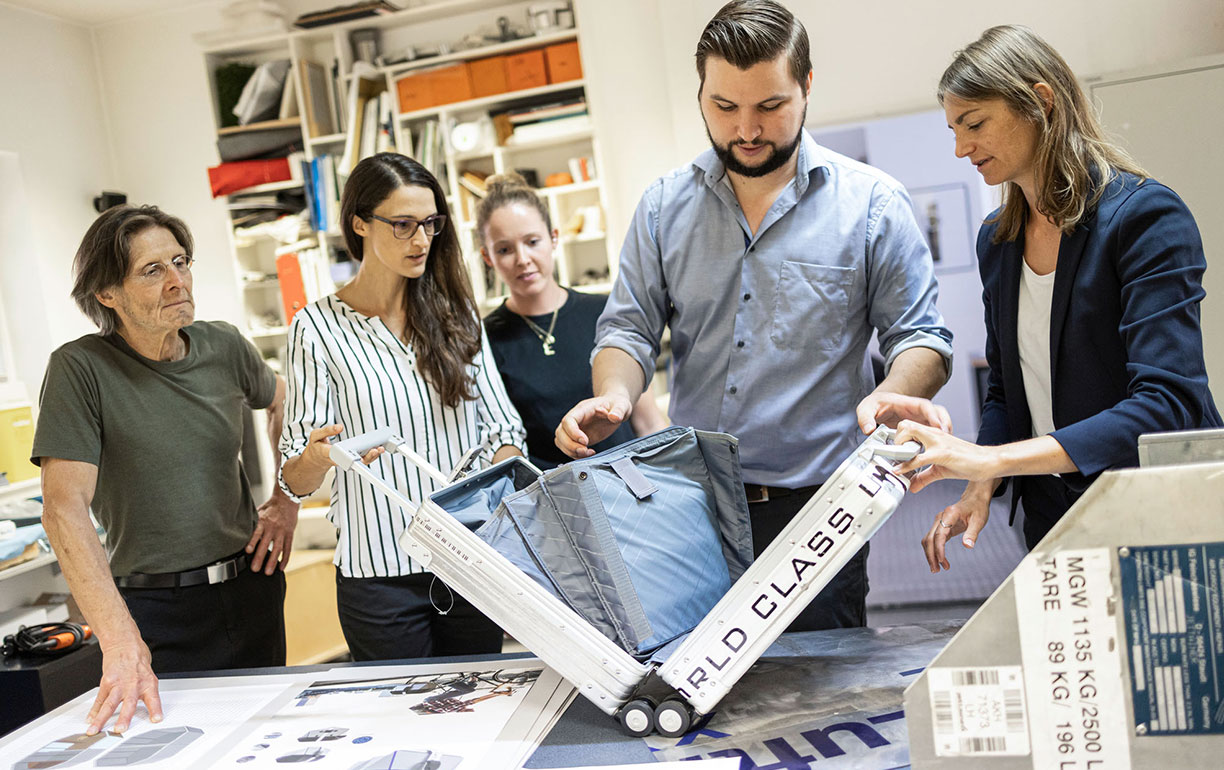
Upcycling Cargo.
Magic potions, miracle drugs, artificial intelligence – in their search for eternal life, humans have always been inventive. But despite all that, a remedy against mortality has not (yet) been found. Similarly, we do yet have a solution for dealing with the growing mountains of waste on our planet. Every person on earth produces 1.5 kilograms of waste per day on average. And the tendency is rising. Unless we do something about it, of course – which we can. Through upcycling, for example. How this might look in practice is demonstrated in a campaign that was launched by four women working for Lufthansa Cargo. Not only does the campaign present some innovative ideas; it also shows us how we can easily extend the time we have on this wonderful planet. If perhaps not forever, then at least for a little while.
Comeback as a designer piece.
“Our recycling rate is now up to almost 100 percent. Our upcycling rate is virtually zero,” says Christina Franz. A senior marketing manager with Lufthansa Cargo, she is one of the four women who, a year ago, launched the campaign that grew out of a support program for young female employees. Also on board are Jule Parulewski, Britta Dechert and Daniela Simon. Their plan is to give freight containers and loading equipment and accessories a new lease on life when they come to the end of their service time rather than taking them to the scrap yard. “But with all enthusiasm we had when we started out, we soon realized that we would not be able to pull this off by ourselves in the long run,” says senior project manager Jule Parulewski. They needed a partner – and they soon found one: the Institute for Recycling, Ecology and Design Frankfurt (IRED). The plan: Lufthansa Cargo would supply the materials and provide the input. The IRED, headed by Professor Werner Lorke, would contribute the creative ideas, the necessary labor and the hardware: lathes, 3-D printers, milling equipment and laser cutters.
In just a few months, the first upcycling products were produced from old loading equipment: travel trolleys made from decommissioned cargo containers. The same material was used to make a wall clock reflecting the airfreight company’s crane esthetic.
Key rings milled from floor plates, and stamped with IATA codes, for example. Designer pieces made from what supposedly were waste materials. Real eye-catchers, the lot of them.
“What was of interest to us in this venture primarily was the global context,” recalls Professor Werner Lorke, who heads the project at the IRED. Frédéric Kreutzer, one of the researchers there: “These airfreight materials have already traveled all over the world. There are dents, scratches, scuff marks, and they all add to the patina of these upcycling products.” It is precisely the kind of “pre-loved” character that they were after. “We live in a world of consumerism that prioritizes new products,” says the professor. “Upcycling has the potential to boost the level of acceptance regarding products made from secondary raw materials.”
The people at the IRED were now all fired up. The professor promptly launches a seminar at the Offenbach University for Art and Design (HfG), where he teaches. The task: to design sustainably produced, practical objects made from discarded airfreight equipment. Here, too, they work closely with the quartet from Lufthansa Cargo. The rush is on: more than 30 students sign up for the workshop.
Comeback as a designer piece.
|
“Our recycling rate is now up to almost 100 percent. Our upcycling rate is virtually zero,” says Christina Franz. A senior marketing manager with Lufthansa Cargo, she is one of the four women who, a year ago, launched the campaign that grew out of a support program for young female employees. Also on board are Jule Parulewski, Britta Dechert and Daniela Simon. Their plan is to give freight containers and loading equipment and accessories a new lease on life when they come to the end of their service time rather than taking them to the scrap yard. “But with all enthusiasm we had when we started out, we soon realized that we would not be able to pull this off by ourselves in the long run,” says senior project manager Jule Parulewski. They needed a partner – and they soon found one: the Institute for Recycling, Ecology and Design Frankfurt (IRED). The plan: Lufthansa Cargo would supply the materials and provide the input. The IRED, headed by Professor Werner Lorke, would contribute the creative ideas, the necessary labor and the hardware: lathes, 3-D printers, milling equipment and laser cutters. In just a few months, the first upcycling products were produced from old loading equipment: travel trolleys made from decommissioned cargo containers. The same material was used to make a wall clock reflecting the airfreight company’s crane esthetic. |
Key rings milled from floor plates, and stamped with IATA codes, for example. Designer pieces made from what supposedly were waste materials. Real eye-catchers, the lot of them. “What was of interest to us in this venture primarily was the global context,” recalls Professor Werner Lorke, who heads the project at the IRED. Frédéric Kreutzer, one of the researchers there: “These airfreight materials have already traveled all over the world. There are dents, scratches, scuff marks, and they all add to the patina of these upcycling products.” It is precisely the kind of “pre-loved” character that they were after. “We live in a world of consumerism that prioritizes new products,” says the professor. “Upcycling has the potential to boost the level of acceptance regarding products made from secondary raw materials.” The people at the IRED were now all fired up. The professor promptly launches a seminar at the Offenbach University for Art and Design (HfG), where he teaches. The task: to design sustainably produced, practical objects made from discarded airfreight equipment. Here, too, they work closely with the quartet from Lufthansa Cargo. The rush is on: more than 30 students sign up for the workshop. |

Thinking globally.
One of them is Emilie Burfeind. Working in a team with three of her fellow students, the 25-year-old is developing an upcycling concept that goes far beyond mere esthetics. Together they build an urban farm using decommissioned cargo containers. “The idea takes inspiration from the concept of aquaponics,” she explains. “It is a closed circuit linking aquaculture and hydroculture.” The model representing the farm has two floors. The top floor is symbolically draped in moss. On the bottom floor small fish made from paper are suspended on pieces of string. Whatever people do not use as food will be recycled. Small animals such as fish and chickens feed on the waste from crops. Their excrements in turn become fertilizer for the new crop seed. Could this be the future for agriculture? “The trend is clearly pointing towards self-sufficiency,” Burfeind is convinced. “Mountains of waste, a growing population, dwindling resources – we need solutions that can compensate for all this.” She sees the urban farm as one way people can provide for themselves autonomously – whether they live in rural Africa or in the middle of Tokyo.
The other participants in the seminar are equally creative, developing sustainable solutions from old airfreight containers: alternative environments for people waiting in departure halls, sleeping berths and pieces of furniture. And there are backpacks, bicycle bags and camera straps among the objects they create, made from old tarpaulins, safety belts and lashing straps. Floor plates become the raw material for handsome bottle openers, for example.
All these ideas are right on target. At the “transport logistic” trade fair in Munich, where the team members present their first prototypes, people are already asking about mass production. Lufthansa Cargo CEO Peter Gerber is the project’s patron. The travel trolleys are currently being developed further, and work is ongoing on fine-tuning the sales and distribution concepts. It is also envisaged that any future proceeds from the products should go to environmental initiatives.
|
The other participants in the seminar are equally creative, developing sustainable solutions from old airfreight containers: alternative environments for people waiting in departure halls, sleeping berths and pieces of furniture. And there are backpacks, bicycle bags and camera straps among the objects they create, made from old tarpaulins, safety belts and lashing straps. Floor plates become the raw material for handsome bottle openers, for example.
|
All these ideas are right on target. At the “transport logistic” trade fair in Munich, where the team members present their first prototypes, people are already asking about mass production. Lufthansa Cargo CEO Peter Gerber is the project’s patron. The travel trolleys are currently being developed further, and work is ongoing on fine-tuning the sales and distribution concepts. It is also envisaged that any future proceeds from the products should go to environmental initiatives.
|

The team inspects work that is made to measure: Professor Werner Lorke from the IRED, Christina Franz from Lufthansa Cargo, Emilie Burfeind, a student at the HfG, Frédéric Kreutzer, a researcher at the IRED, and Jule Parulewski from Lufthansa Cargo (l. to r.)
The small difference that really matters.
The small difference that really matters.
Recycling
Recycling is the generic term used to cover all the different recycling methods. The word means “to return something to the cycle”. A recyclable material is thus given back to the consumer in a new form. A classic example: disused PET bottles are turned into granulate, and this is then used to make fleece jackets and packaging materials.
Downcycling
Unlike standard recycling, here the waste is turned into a product of lower quality. When recycling paper, for example, it is not possible to fully match the quality of the original product. However, this does not detract from the benefit of recycling in terms of sustainability. Downcycling is something we can all do in our everyday lives: simply print paper double-sided, or reuse the reverse side of paper that has already been printed on one side.
Upcycling
This is also a form of recycling, but here esthetics assumes a pivotal role. Products that are made from waste and are often artistically augmented using other materials and then actually increase in value. Ideally, the resulting product turns out to be a designer object.
Photos: Alex Kraus
